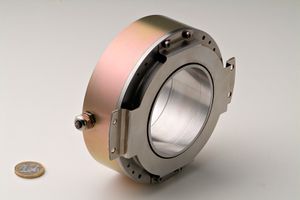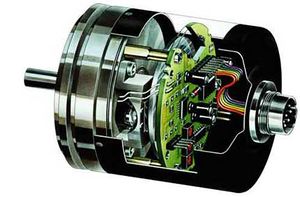Incremental Encoders
Incremental Encoders provide incremental motor position information via two channels, referred to as the A Channel and B Channel. These channels output a specific number of pulses for a unit of shaft motion. These pulses are typically generated within the incremental encoder using an optical disk directly connected to the motor shaft. The disk has etchings on it that either transmit or block light passing through the disk. An optical transmitter and receiver sit on either side of the disk. The rotation of the disc and motor shaft interrupts light transmission from source to receiver, creating pulses. The interruptions on the disk are called lines and result is the encoder's rating of lines-per-revolution (LPR), sometimes referred to as pulses per revolution (PPR).
Zero Pulse
Incremental Encoders are often provided with an additional channel called a Marker channel, Zero Pulse, or an Index channel. These are merely different names for the same function. This channel outputs one pulse-per-revolution and is typically an extremely narrow pulse equating to roughly ¼ of the width of an A or B channel pulse, but can be wider. This is a reference position marker used for homing (absolute position reference) and commutation alignment.
Commutation Tracks
One challenge when using incremental encoders for commutating a brushless motor is that they are incremental devices rather than absolute devices. At power-up with an absolute device such as a resolver, the device transmits a code that is unambiguous to any position within its rotation. In other words, at power-up, the system knows the position of the motor shaft. Incremental encoders are incremental devices, meaning that there is no way to know exactly the position of the shaft at power up, only how far it has moved from its original position. This presents a problem with three-phase brushless motors in terms of commutation alignment. It is extremely important to establish the appropriate commutation angle within the controller.
One solution to determine the absolute motor axis position after switching on the drive is the so called wake and shake .With this function the motor axis is moved for and back a little bit. The values that are measured during this movement are used to determine the actual position of the axis.For this reason, Encoders or motors are often provided with additional channels sometimes called commutation tracks or hall emulation tracks which provide 1-part-in-6 absolute position information .
Differences between absolute and incremental encoders
There are a few subtle differences between absolute and incremental rotary encoders. Incremental encoders have output signals that repeat over the full range of motion. It is important to understand that each mechanical position is not uniquely defined. When the incremental encoder is turned on, the position of an incremental encoder is not known since the output signals are not unique to any singular position. Absolute Encoders have a unique value for each mechanical position. When an absolute encoder is turned on, the position of an absolute encoder is known . The similarities of both absolute and incremental encoders are form factor and the issues of count and directional information. They can be obtained from both absolute and incremental encoders equally.

